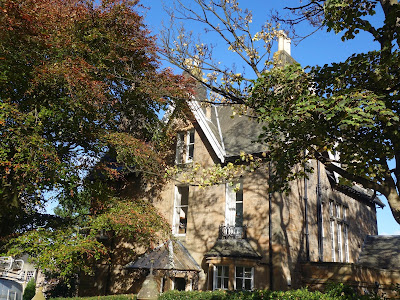 |
| Langside Monument |
I visited our old neighbourhood on the south side of Glasgow yesterday, taking advantage of a perfect late autumn day and catching a bus to the Battlefield Rest. When we lived there, it was a run-down public transport waiting room but now hosts a cafe. We spent over seven years living in
Langside/Battlefield during the early years of family life in the 1980s. We bought a blonde sandstone Edwardian semi on Millbrae Road across from the Mansionhouse Road Hospital that has been demolished and replaced by flats.
The house was built on a sloping site and had 3 floors and a large unruly garden. We moved in with our two-month-old baby and a large mortgage after rewiring the house. We huggled our way through the first winter and installed central heating the following year. Over the next four years, two more children arrived, all the rooms were decorated, the garden was tamed and an off-road parking place was created. The house had many attractive period features including decorative cornices, dado rails, marble fireplaces, high ceilings and pitch pine doors. It had seen little modernisation before we bought it although the downstairs drawing room had been subjected to decorator's cancer - Artex.
Even in the seven years that we were there the traffic on Millbrae Road increased dramatically with all the noise and fumes that this entails. Following a burglary whilst we were on holiday, we felt less secure and decided to move out of the city. It was a wrench to leave the house we had invested so much time and money in to create a comfortable home. We had made many new friends with other families in the area. The friendships had been cemented by the children and all the mutual support that emerges through playgroups, babysitting, children's parties and outings to parks and the seaside.
Battlefield Nursery and Primary School had been a good place for the two girls to start their education with children from many ethnic groups. The local library was used regularly, the Victoria Infirmary A&E was only 3 minutes away and the children did have accidents. We had a local butcher, greengrocer and Italian ice cream shop and it was only 15 minutes to Pollock Grounds. This became the venue for outings with our visitors particularly after the Burrell Collection opened.
My journey to work was a relatively easy 30 minutes by either bus, train, car or running. Queen's Park was 2 minutes away and provided an exact 2 mile run around the perimeter that became a staple part of my training when I started to run again in 1982. I went out most evenings after 9:00pm and managed to get my PB down to 10:15. I ran to and from work about twice a week, the direct route for the morning run was just 4 miles. The run home was either a 7-mile route via Pollok Grounds or 10 miles via Bellahouston Park and Pollock Grounds.
I was reluctant to move to the suburbs and Aileen wished to live in a more rural environment so we leapfrogged to the Trossachs. It was to be nearer grandparents, to have access to the trails and hills, to avoid the noise and fumes of traffic and to find a safer environment after the break-in. I had spent the first 40 years of my life in cities so it was quite a shock. We moved on a late November day and spent several days unpacking boxes and discovering the cold reality of an old stone house in winter. The children were welcomed to the new primary school and I quickly began to appreciate the 200 miles of trails in the forest that became my playground and gymnasium for the next 30 years. The only downside was the daily 26-mile and 50-minute commute to Glasgow but after 3 years that was superseded by the far easier trip to Stirling, just 25 minutes on quiet roads with breathtaking and tantalising views as I returned home.
 |
| Battlefield Rest |
 |
| Victoria Infirmary balconies on the Nightingale wards |
 |
| Langside Hill Church or restaurant now |
 |
| Home for 7 years |
 |
| The rear of the house on the left |
 |
| Battlefield Primary School |
 |
| Battlefield Primary P1 classroom |





























































